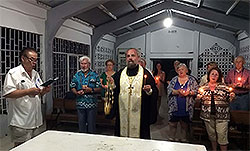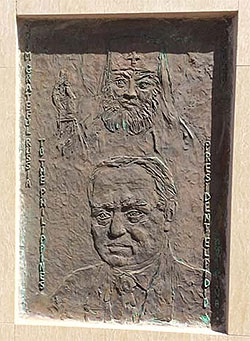
PHILIPPINES: November 27, 2015
The Russians of Tubabao Are Remembered
 On November 15-18, 2015, events were held to mark the memory of the Russians who found hospice on the island of Tubabao between 1949-1951. These were refugees from China led by St John of Shanghai. On November 15-18, 2015, events were held to mark the memory of the Russians who found hospice on the island of Tubabao between 1949-1951. These were refugees from China led by St John of Shanghai.
Descendants of the refugees who now live in Australia and the USA attended the ceremonies, along with the head of the Coordinating Council of Russian Compatriots in the USA, Mrs NG Sabelnik, who lived in Tubabao with her parents until she was three.
She and TV Tabolina, a member of the Institute of Ethnology and Anthropology of the RAN gave speeches on the Russian experience in Tubabao.
 With the blessing of His Grace Bishop Sergius of Solnechnogorsk, Hegumen Pavel (Khokhlov) of Archangel Michael Church in Kuala Lumpur, Malaysia, performed a pannikhida over the graves of the Russians buried in Guyana, Tubabao. A choir from Berkeley, CA, sang under the direction of Nikolai Masenkov of St John the Baptist Church, who was the spiritual son of St John during his days in Shanghai. With the blessing of His Grace Bishop Sergius of Solnechnogorsk, Hegumen Pavel (Khokhlov) of Archangel Michael Church in Kuala Lumpur, Malaysia, performed a pannikhida over the graves of the Russians buried in Guyana, Tubabao. A choir from Berkeley, CA, sang under the direction of Nikolai Masenkov of St John the Baptist Church, who was the spiritual son of St John during his days in Shanghai.
Later that day, a meeting was held with teachers and students of a local school in Tubabao. Prayers were sung, after which all in attendance received printed icons blessed by His Holiness Patriarch Kirill of Moscow and All Russia.
The next day, representatives of the Russian Orthodox Church participated in the consecration of a center dedicated to the memory of the Russian refugees in Tubabao. The complex is comprised of three walls with memorial plaques donated by the Russian Embassy in Manila, a representative of the United Nations Supreme Commissariat for Refugees in the Philippines and the President Elpidio Cirino Foundation (he was the sixth president of the nation who in 1949 granted asylum to the Russian refugees in 1949). One plaque includes depictions of President Cirino and St John of Shanghai.
Attending the event were many residents of Tubabao, including seniors who fondly remembered the Russian refugees.
The political changes in China in 1948 forced many Russian emigres living in Peking, Tyanzin, Tsing-dao, Hankow and other cities to move to Shanghai. The UN Refugee Organization helped them, seeking permission from several nations for the refugees to resettle. The only country to respond was the Republic of the Philippines, which granted the refugees permission to settle in Tubabao, on the southern part of the island chain connected to the Island of Samar by a bridge.
The evacuation from Shanghai began in January, 1949, and continued until May of that year. Some five and a half thousand men, women and children, mostly Russians, arrived via boat and plane. A large tent city was set up, which included two tent-churches dedicated to Archangel Michael and St Seraphim of Sarov. A large cathedral devoted to the Mother of God was also established in a building once housing an American military chaplaincy. In April, 1949, Archbishop John (Maximovich) arrived here, after which he departed for the USA in order to gain asylum for the Russians of Tubabao. Eventually, the refugees found new homes in the USA, Australia and Latin America. After the last of the emigres left Tubabao in 1953, the camp was closed.

|